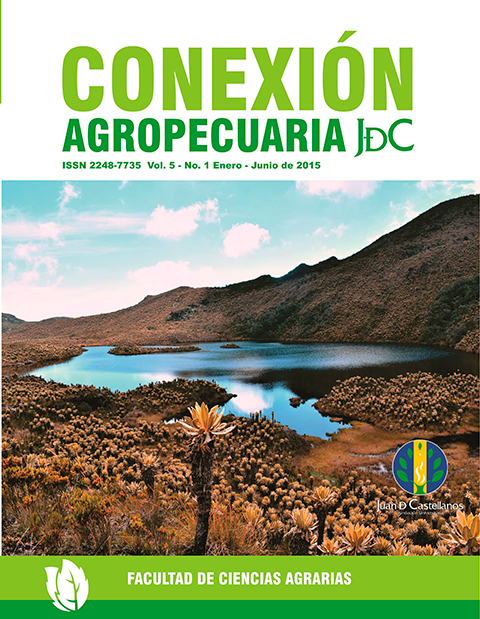Palabras clave:
Acari, control biológico, deltaendotoxinas, esporulación, toxicidadResumen
Existen aproximadamente 55.000 especies de Acari, muchas de estas son parásitos y afectan plantas, animales y seres humanos, causando pérdidas económicas y problemas de salud pública. Uno de los agentes biológicos más utilizados para el control de insectos y ácaros plaga es Bacillus thuringiensis, bacteria entomopatógena, ubicua, que en ensayos de campo ha mostrado toxicidad sobre ácaros parásitos de animales y plantas. El propósito de esta revisión fue analizar el estado del arte de la utilidad de B. thuringiensis sobre el control de ácaros plaga.
Descargas
Citas
ARANGO, J. A., ROMERO, M. & ORDUZ, S. 2002. Diversity of Bacillus thuringiensis strains from Colombia with insecticidal activity against Spodoptera frugiperda (Lepidoptera: Noctuidae). Journal of Applied Microbiology 92(3): 466-474.
BEAULIEU, F. A., DOWLING, P. G., KLOMPEN, H., DE MORAES, G. J. & REFERENCIAS BIBLIOGRÁFICAS WALTER, D. E. 2011. Superorder parasitiformes Reuter, 1909. In Z.-Q. Zhang (Ed.), Animal biodiversity: An outline of higher- level classification and survey of taxonomic richness. Auckland: Magnolia Press. 123-128.
BERLINER, E. 1915. Überdie Schlaffsucht der Mehlmottenraupe (Ephestia kühniella Zell.) und ihren Erreger Bacillus thuringiensis n. sp. Zeitschrift für angewandte Entomologie 2(1): 29-56.
BERNHARD, K. , JARRETT, P. , MEADOWS, M., BUTT, J., ELLIS, D. J., ROBERTS, G. M. & BURGES, H. D.1997. Natural Isolates of Bacillus thuringiensis: Worldwide Distribution, Characterization, and Activity against Insect Pests. Journal of Invertebrate Pathology 70(1): 59-68.
BOWMAN, D. D. 2011. Georgis: Parasitología veterinaria. Novena edición. Elsevier saunders. Barcelona, España. 60-79.
BRAVO, A., SARABIA, S., LÓPEZ, L., ONTIVEROS, H., ABARCA, C., ORTIZ, A . & QUINTERO, R. 1998. Characterization of cry genes in a Mexican Bacillus thuringiensis strain collection. Applied and Environmental Microbiology 64(12): 4965-4972.
BRAVO, A. , SÁNCHEZ, J. , KOUSKOURA, T. & CRICKMORE, N. 2002. N-terminal activation is an essential early step in the mechanism of action of the B. thuringiensis Cry1AC insecticidal toxin. The Journal of Biological Chemistry 227: 23985-23987.
BRAVO, A., BUITRAGO, G., CERÓN, W., MARTÍNEZ, J., JUÁREZ-PÉREZ, V. & URIBE, D. 2004. Bacillus thuringiensis en el control biológico. En: Bravo A. & Cerón J. (eds). Bacillus thuringiensis en el control biológico. La buena semilla, Bogotá- Colombia. 294 pp.
CALDERÓN, A. V., HERNÁNDEZ FONSECA, V. & HERNÁNDEZ - GAMBOA, A. 2005. Catálogo de garrapatas suaves (Acari: Argasidae) y duras (Acari: Ixodidae) de Costa Rica. Brenesia 65: 81-88.
CANO, E., LÓPEZ, J. A., CANO, E., CARBALLO, C. V. & GUHARAY, F. 2004. Control biológico de plagas agrícolas (No. 53). Bib. Orton IICA/CATIE.
CHAPMAN, M.H. & HOY, M.A. 1991. Relative toxicity of Bacillus thuringiensis var. tenebrionis to the two-spotted spider mite (Tetranychus urticae Koch) and its predator (Metaseialus occidentalis (Nesbitt)) (Acari, Tetranychidae and Phytoseidae). Journal of Applied Entomology 111:147-154.
COHEN, E. 1987. Interference with chitin biosynthesis in insects. In Chitin and benzoylphenyl ureas. Springer Netherlands. 43-73.
CODDINGTON, J. A., GIRIBET, G., HARVEY, M. , PRENDINI, L. & WALTER, D. 2004. Arachnida. In: Cracraft J., Donoghue M. J. (eds), Assembling the Tree of Life. Oxford University Press, Oxford. 296-318.
CRICKMORE, N., ZEIGLER, D. R., FEITELSON, J., SCHNEPF, E., VAN RIE, J., LERECLUS, D., & DEAN, D. H. 1998. Revision of the nomenclature for the Bacillus thuringiensis pesticidal crystal proteins. Microbiology and Molecular Biology Reviews 62(3): 807-813.
DE CASTRO, T. R., AUSIQUE, J. J. S., NUNES, D. H., IBANHES, F. H. & JÚNIOR, I. D. 2013. Risk assessment of Cry toxins of Bacillus thuringiensis on the predatory mites Euseius concordis and Neoseiulus californicus (Acari: Phytoseiidae). Experimental and applied acarology 59(4): 421-433.
DE MAAGD, R. A., BRAVO, A., BERRY, C., CRICKMORE, N., & SCHNEPF, H. E. 2003. Structure, diversity, and evolution of protein toxins from spore-forming entomopathogenic bacteria. Annual review of genetics 37(1): 409-433.
DÍAZ, J. H. 2006. The epidemiology, diagnosis, management and prevention of ectoparasitic diseases in travelers. Journal of Travel Medicine 13: 100-11.
DABROWSKI, Z. T., CZAJKOWSKA, B. & BOCINSKA, B. 2006. First experiments on unintended effects of B. thuringiensis maize feed on non-target organisms in Poland. IOBC WPRS BULLETIN 29(5): 39.
DUNLOP, J. A., & ALBERTI, G. 2007. The affinities of mites and ticks: a review. Journal of Zoological Systematics and Evolutionary Research 46(1): 1-18.
DUNSTAND-GUZMÁN, E., PEÑACHORA, G., HALLAL-CALLEROS, C., PÉREZ-MARTÍNEZ, M., HERNÁNDEZVELÁZQUEZ, V. M., MORALESMONTOR, J. & FLORES-PÉREZ, F. I. 2015. Acaricidal effect and histological damage induced by Bacillus thuringiensis protein extracts on the mite Psoroptes cuniculi. Parasites & vectors 8(1): 285.
ERBAN, T. , NESVORNA, M. , ERBANOVA, M. & HUBERT, J. 2009. Bacillus thuringiensis var. tenebrionis control of synanthropic mites (Acari: Acaridida) under laboratory conditions. Experimental and Applied Acarology 49(4): 339-346.
FAUST, R. & BULLA J. 1982. Bacteria and their toxins as insecticides. Microbial and Viral Pesticides, E. Kurstak, Ed., Marcel Dekker, NY. 84-89.
FEITELSON, J. S. 1993. The Bacillus thuringiensis family tree. Advanced engineered pesticides. 63-72.
FERNÁNDEZ-RUVALCABA, M., PEÑA-CHORA, G., ROMO-MARTÍNEZ, A., HERNÁNDEZ-VELÁZQUEZ, V., DE LA PARRA, A. B. & DE LA ROSA, D. P. 2010. Evaluation of Bacillus thuringiensis pathogenicity for a strain of the tick, Rhipicephalus microplus, resistant to chemical pesticides. Journal of Insect Science 10(1): 186.
FORD, M. G., & SALT, D. W. 1987. Behaviour of insecticide deposits and their transfer from plant to insect surfaces. In: Pesticides on plant surfaces/edited by HJ Cottrell. Great Britain. p. 86.
GARCÍA-ROBLES, I., SÁNCHEZ, J., GRUPPE, A., MARTÍNEZ-RAMÍREZ, A. C., RAUSELL, C., REAL, M. D. & BRAVO, A. 2001. Mode of action of Bacillus thuringiensis PS86Q3 strain in hymenopteran forest pests. Insect Biochemistry and Molecular Biology 31(9): 849-856.
GONZÁLEZ-CABRERA, J., MOLLÁ, O., MONTÓN, H., & URBANEJA, A. 2011. Efficacy of Bacillus thuringiensis (Berliner) in controlling the tomato borer, Tuta absoluta (Meyrick) (Lepidoptera: Gelechiidae). BioControl 56(1): 71-80.
GRIFFITTS, J. S. & AROIAN, R. V. 2005. Many roads to resistance: how invertebrates adapt to B. thuringiensis toxins. Bioessays 27(6): 614-624.
GU, X. B., LIU, G. H., SONG, H. Q., LIU, T. Y., YANG, G. Y. & ZHU, X. Q. 2014. The complete mitochondrial genome of the scab mite Psoroptes cuniculi (Arthropoda: Arachnida) provides insights into Acari phylogeny. Parasites & vectors 7(1): 1-10.
GULATI, R. 2014. Eco- Friendly Management of Phytophagous Mites. In: Entomology and pest management. Waveland Press. P343.
GUO, Y.-L., ZUO, G.-S., ZHAO, J.-H., WANG, N.-Y. & JIANG, J.-W. 1993. A laboratory test on the toxicity of thuringiensin to Tetranychus urticae (Acari: Tetranychidae) and Phytoseiulus persimilis (Acari: Phytoseiidae). Chinese Journal of Biological Control 9: 151-155.
GUTIÉRREZ, M. E. M., VEGA, O. F. L., MENA, D. D., DÍAZ, A. & SOLÍS, B. C. 2003. Evaluación de un producto de Bacillus thuringiensis para el control de la varroasis. Fitosanidad 7(1): 3-8.
HASSANAIN, M.A., EL GARHY, FM., ABDEL-GHAFFAR, AF., EL-SHARABY, A. & ABDEL MEGEED, N. K. 1997. Biological control studies of soft and hard ticks in Egypt. I. The effect of Bacillus thuringiensis varieties on soft and hard ticks (Ixodidade). Parasitology Reserch 83: 209- 213.
HEIMPEL, A. M. 1967. A critical review of Bacillus thuringiensis var. thuringiensis Berliner and other crystalliferous bacteria. Annual Review of Entomology 12: 287–322.
HERNÁNDEZ, C. S., MARTÍNEZ, C., PORCAR, M., CABALLERO, P. & FERRÉ, J. 2003. Correlation between serovars of Bacillus thuringiensis and type I β-exotoxin production. Journal of invertebrate pathology 82(1): 57-62.
HERNÁNDEZ - FERNÁNDEZ , J . , RAMÍREZ, L. , RAMÍREZ, N . , FUENTES, L. S. & JIMÉNEZ, J. 2011. Molecular and biological characterization of native Bacillus thuringiensis strains for controlling tomato leafminer (Tuta absoluta Meyrick) (Lepidoptera: Gelechiidae) in Colombia. World Journal of Microbiology and Biotechnology 27(3): 579-590.
HÖFTE, H. & WHITELEY, H. R. 1989. Insecticidal crystal proteins of Bacillus thuringiensis. Microbiological reviews, 53(2), 242-255.
HONGYU, Z., ZINIU, Y. & WANGXI, D. 2000. Composition and Ecological Distribution of Cry Proteins and Their Genotypes of Bacillus thuringiensis Isolates from Warehouses in China. Journal of invertebrate pathology 76(3): 191-197.
HOY, M. A., & OUYANG, Y. L. 1987. Toxicity of the β-exotoxin of Bacillus thuringiensis to Tetranychus pacificus and Metaseiulus occidentalis (Acari: Tetranychidae and Phytoseiidae). Journal of economic entomology 80(2): 507-511.
IRAOLA, V. 2001. Introducción a los ácaros (II): Hábitats e importancia para el hombre. Boletín Sociedad Entomológica Aragonesa 28: 141-146.
ITOUA-APOYOLO, C., DRIF, L., VASSAL, J. M., DEBARJAC, H., BOSSY, J. P., LECLANT, F., & FRUTOS, R. 1995. Isolation of Multiple Subspecies of Bacillus thuringiensis from a Population of the European Sunflower Moth, Homoeosoma nebulella. Applied and environmental microbiology 61(12): 4343- 4347.
JAVED, S., KHAN, F., RAMÍREZ-FORT, M., & TYRING, S. K. 2013. Bites and mites: prevention and protection of vectorborne disease. Current opinion in pediatrics 25(4): 488-491.
JOFRÉ, L., NOEMI, I., NEIRA, P., SAAVEDRA, T. & DÍAZ, C. 2009. Acarosis y zoonosis relacionadas. Revista chilena de infectología 26(3): 248-257.
KRIEG, A. 1971. Concerning -exotoxin poduced by vegetative cells of Bacillus thuringiensis and Bacillus cereus. Journal Invertebrary Pathology 17:134-135.
LEE, M. K., WALTERS, F. S., HART, H., PALEKAR, N. & CHEN, J. S. 2003. The mode of action of the Bacillus thuringiensis vegetative insecticidal protein Vip3A differs from that of Cry1Ab δ-endotoxin Bacillus thuringiensis on the phylloplane of species of Piper (Piperaceae) in three altitudinal levels. Microbial ecology 44(2): 144-153.
LINDQUIST, E. E. 1998. Evolution of phytophagy in trombidiform mites. Experimental & Applied Acarology 22: 81–100.
LOGAN, N. A. & DE VOS, P. 2009. Genus I. Bacillus Cohn 1872, 174AL. In: De Vos, P., Garrity, G.M., Jone,s D., Krieg, N. ,R., Ludwig W., Rainley F.A., Schleifer K.H., Whitman W.B. (eds): Bergey's manual of
systematic bacteriology, 2nd edn, Vol. 3, Springer, New York. 22-128.
MAEDA, M. , MIZUKI, E. , NAKAMURA, Y., HATANO, T. & OHBA, M. 2000. Recovery of Bacillus thuringiensis from marine sediments of Japan. Current microbiology 40(6): 418- 422.
MADUELL, P. , CALLEJAS, R . , CABRERA, K. R., ARMENGOL, G. & ORDUZ, S. 2002. Distribution and characterization of Bacillus thuringiensis on the phylloplane of species of Piper (Piperaceae) in three altitudinal levels. Microbial ecology 44(2): 144-153.
MARTIN, P. A. & TRAVERS, R. S. 1989. Worldwide abundance and distribution of Bacillus thuringiensis isolates. Applied and Environmental Microbiology 55(10): 2437-2442.
MARTÍNEZ, C. & CABALLERO, P. 2002. Contents of cry genes and insecticidal toxicity of Bacillus thuringiensis strains from terrestrial and aquatic habitats. Journal of applied microbiology 92(4): 745-752.
MCCOY, K. D. , LÉGER, E. , & DIETRICH, M. 2013. Host specialization in ticks and transmission of tick-borne diseases: a review. Frontiers in cellular and infection microbiology 3:57-68.
MEADOWS, M. P., ELLIS, D. J., BUTT, J., JARRETT, P. & BURGES, H. D. 1992. Distribution, frequency, and diversity of Bacillus thuringiensis in an animal feed mill. Applied and Environmental Microbiology 58(4): 1344-1350.
MILANI, N. 1999. The resistance of Varroa jacobsoni Oud. to acaricides. Apidologie 30: 229-234.
MORENO, J. , GERECKE, R. & TUZOVSKIJ, P. 2008 Biology and taxonomic position of an ovoviviparous water mite (Acari: Hydrachnidia) from a hypersaline spring in southern Spain. Aquat Insect 30(4):307–317.
NAJAFABADI, S. S. M., SHOUSHTARI, R. V., ALI ZAMANI, A., ARBABI, M. & FARAZMAND, H. 2011. Effect of nitrogen fertilization on Tetranychus urticae Koch (Acari: Tetranychidae) populations on common bean cultivars. Middle-East Journal of Scientific Research 8(5): 990-998.
NEAL, J., LINDQUIST, R., GOTT, K., & CASEY, M. 1989. Activity of the Thermostable B-exotoxin of B. thuringiensis Berliner on T. urticae and T. cinnabarinus. Journal of Agricultural Entomology 4(1): 33-40.
OCHOA, R., AGUILAR, H., & VARGAS, C. 1991. Ácaros fitófagos de América Central: guía ilustrada (No. 6). Centro Agronómico Tropical de Investigación y Enseñanza. Costa Rica. 251pp.
OLIVEIRA, A. R., CASTRO, T. R., CAPALBO, D. M. & DELALIBERA J. 2007. Toxicological evaluation of genetically modified cotton (Bollgard®) and Dipel® WP on the non-target soil mite Scheloribates praeincisus (Acari: Oribatida). Experimental and Applied Acarology 41(3): 191-201.
PAYNE, J. M., CANNON, R. J. & BAGLEY, A. L., (1993). Bacillus thuringiensis isolates for controlling acarides. US5211946 A.
PINNOCK, D.E. 1994. The use of Bacillus thuringiensis for control of pests of livestock. Agriculture, Ecosystems and Environment 49: 59-63.
ROBAINA, Y. B., JIMÉNEZ, C. L. & CORCUERA, G. D. 2006. Detección de Bexotoxina en cepas nativas de Bacillus thuringiensis por HPLC. Fitosanidad 10(4): 255-259.
ROSENKRANZ, P., AUMEIER, P. & ZIEGELMANN, B. 2010. Biology and control of Varroa destructor. Journal of invertebrate pathology 103: S96-S119.
ROVENSKÁ, G. Z., ZEMEK, R., SCHMIDT, J. E. & HILBECK, A. 2005. Altered host plant preference of Tetranychus urticae and prey preference of its predator Phytoseiulus persimilis (Acari: Tetranychidae, Phytoseiidae) on transgenic Cry3Bb-eggplants. Biological Control 33(3): 293-300.
ROYALTY, R. N., HALL, F. R. & TAYLOR, R. A. J. 1990. Effects of thuringiensin on Tetranychus urticae (Acari: Tetranychidae) mortality, fecundity, and feeding. Journal of economic entomology 83(3): 792-798.
SAVORY, T. 1972. On the names of the orders of Arachnida. Systematic Biology 21(1): 122-125.
SEBESTA, K., J.FARKAS, HORSKÁ, K. & VANKOVA, J. 1981. Thuringiensin, la beta-exotoxina de Bacillus thuringiensis. En HD Burges (ed.) el control microbiano de plagas y enfermedades de las plantas
1970-1980. Academic Press, Londres, Inglaterra. 249-281.
SCHNEPF, E., CRICKMORE, N., VAN RIE, J., LERECLUS, D., BAUM, J., FEITELSON, J., & DEAN, D. H. 1998. Bacillus thuringiensis and its pesticidal crystal proteins. Microbiology and molecular biology reviews 62(3): 775-806.
STEEN, C. J., CARBONARO, P. A. & SCHWARTZ, R. A. 2004 Arthropods in dermatology. Journal of the American Academy of Dermatology 50: 819-42.
STEVENS, M. & HOGG, I. 2006. The molecular ecology of Antarctic terrestrial and limnetic invertebrates and microbes. In: Bergstrom DM, Convey P, Huiskes AHL (eds) Trends in Antarctic Terrestrial
and Limnetic Ecosystems. Springer, The Netherlands. 177-192.
TYURIN, S. A., MESHKOV, Y. I., YAKOVLEVA, I. N., ZALUNIN, I. A., HASHIMOV, F. H., ZHUZHIKOV, D. P. & DEBABOV, V. G. 2006. A new insecticidal preparation on the basis of Bacillus thuringiensis with insecto-acaricidal activity. IOBC WPRS BULLETIN 29(5): 177.
URIBE, D., MARTÍNEZ, W. & CERÓN, J. 2003. Distribution and diversity of cry genes in native strains of Bacillus thuringiensis obtained from different ecosystems from Colombia. Journal of Invertebrate
Pathology 82(2): 119-127.
VAN FRANKENHUYZEN, K. V. 2009. Insecticidal activity of Bacillus thuringiensis crystal proteins. Journal of invertebrate pathology 101(1): 1-16.
VARGAS, R . , CHAPMAN, B. & PENMAN, D. R. 2001. Toxicidad de thuringiensin en estados inmaduros y adultos de Tetranychus urticae Koch and Panonychus ulmi (Koch) (Acarina: Tetranychidae). Agricultura Técnica 61(1): 3-14.
WALTER, D. & PROCTOR, H. 2013. Mites: Ecology, Evolution & Behaviour: Life at a Microscale, 2ed. Springer Netherlands. 494pp. DOI 10.1007/978-94-007-7164-2_8
XU, Z., YAO, B., SUN, M. & YU, Z. 2004. Protection of mice infected w ith Plasmodium berghei by Bacillus thuringiensis crystal proteins. Parasitology research 92(1): 53-57.
YAMAMOTO, T. & POWELL, G. K. 1993. Bacillus thuringiensis crystal proteins: recent advances in understanding its insecticidal activity. Advanced engineered pesticides. 3-42.
ZEMEK R. & HUBERT, J. 2008. Acaricidal activity of Bacillus thuringiensis toxins against mite pests. IOBC/WPRS Bulletin 31: 122.
ZHANG, Z. -Q. 2013. Phylum Arthropoda. In: Zhang, Z. - Q. (Ed.), Animal biodiversity: An outline of higher –level classification and survey of taxonomic richness (Addenda 2013). Zootaxa 3703(1): 017-026.
ZHIOUA, E., HEYER, K., BROWNING, M., GINSBERG, H. S., & LEBRUN, R. A. 1999. Pathogenicity of Bacillus thuringiensis variety kurstaki to Ixodes scapularis (Acari: Ixodidae). Journal of medical entomology 36(6): 900-902.





